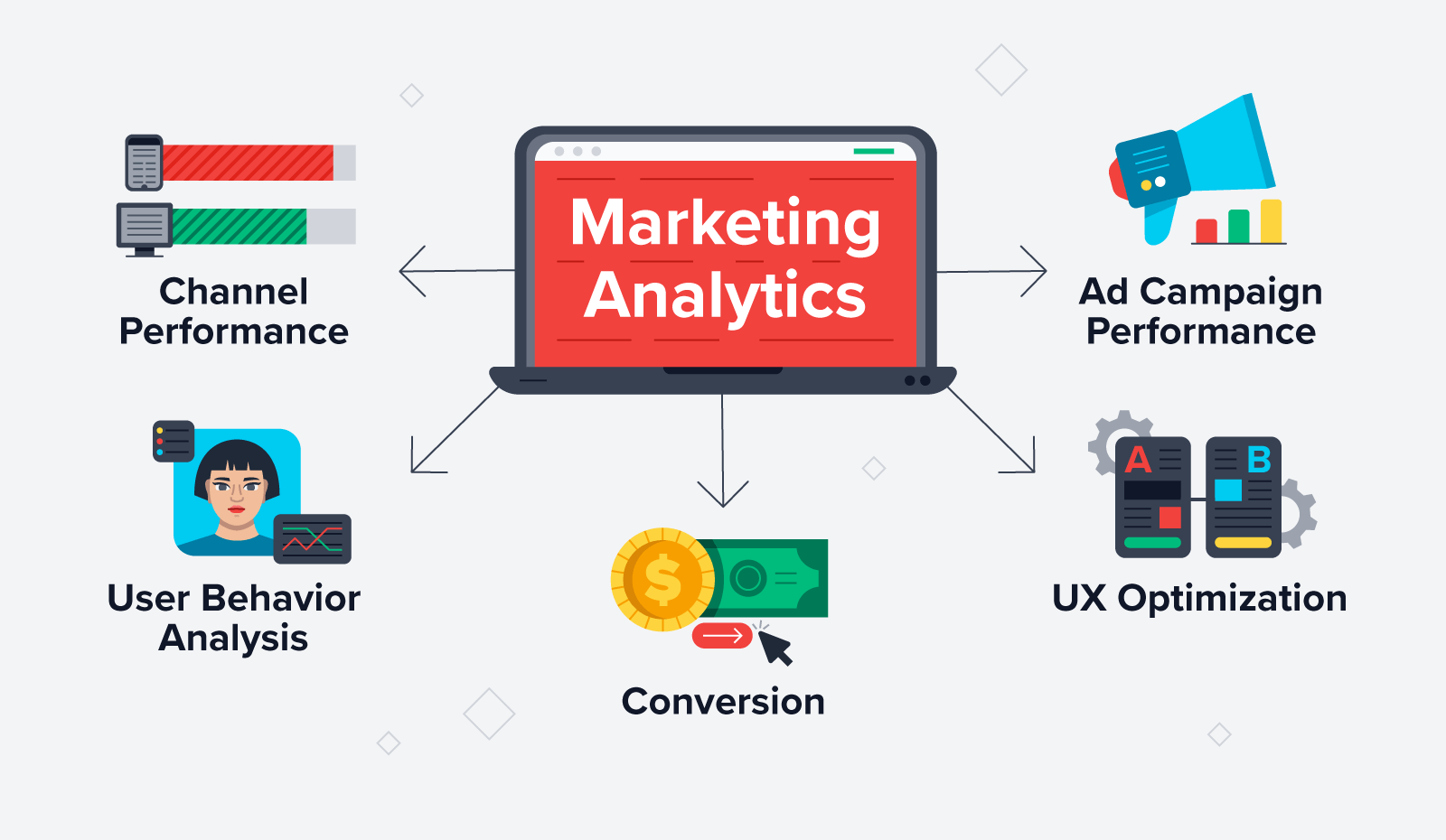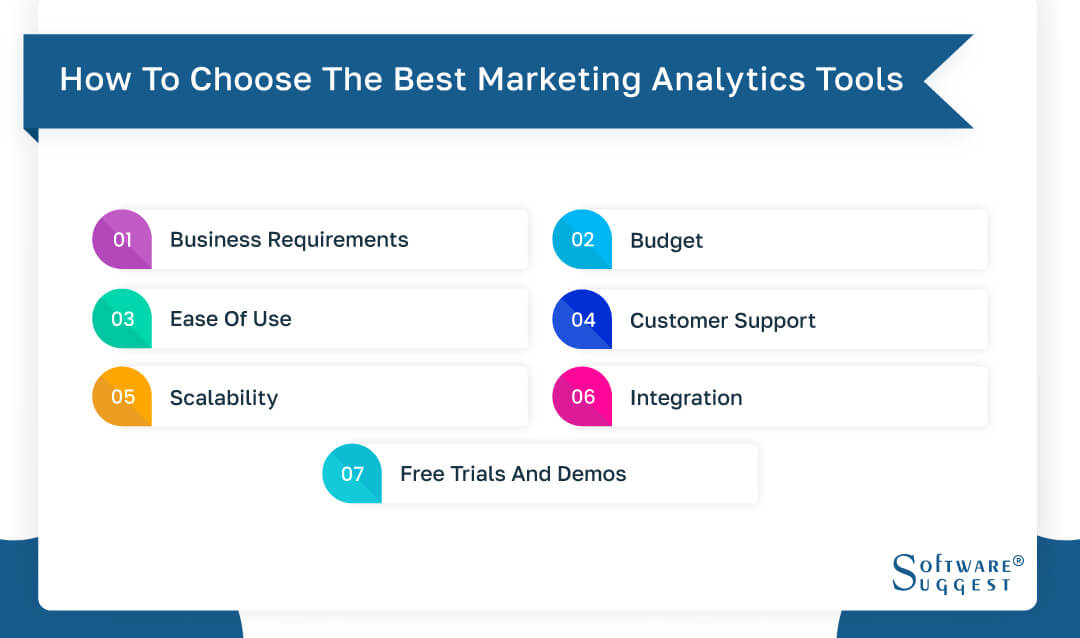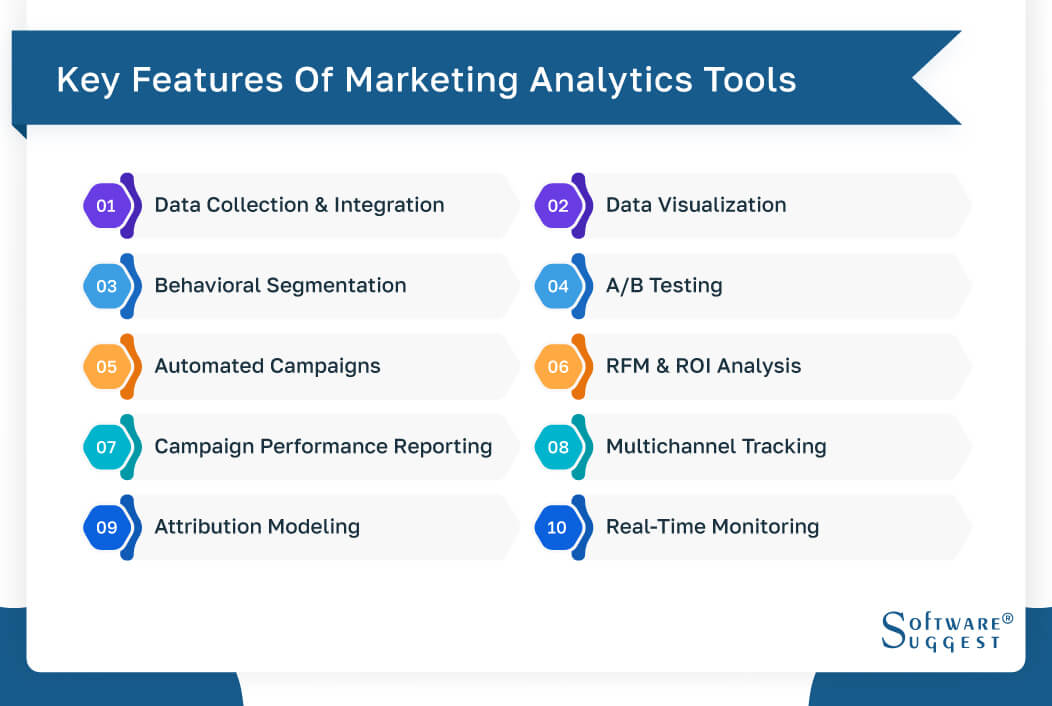Is your business data hard to understand and turn into good choices? You're not alone.
As an owner, there's never enough time in the day. Plus, your data is all over the place, so it's tough to see the full picture. But what if we told you there's a better way?
This blog is here to help businesses like yours deal with data problems and make smarter decisions.
You'll learn practical tips and strategies for getting the right data, seeing patterns and trends, and using visuals that turn numbers into stories.
Best of all, these insights can boost sales and customer satisfaction and make work easier.
Read this blog for easy-to-apply tips that will have you using a data analytic marketing tool like a pro in no time.
Before selecting a marketing analytics tool for your business, it's important to assess your current business needs and goals.
Assessing Your Business Needs
This section will help you assess your business needs to find the right data analytic marketing tool for your goals.
We will explore defining objectives, understanding data requirements, and evaluating current capabilities to select the perfect fit.
Identifying marketing goals and objectives
To begin with, identify what you hope to achieve with your marketing efforts and the outcomes you want to measure.
This can include objectives such as increasing website traffic, generating leads, improving conversion rates, or increasing customer retention.
Having clearly defined goals will help you to identify which marketing analytics tools are most suitable for your business.
Understanding data requirements

It's also essential to understand the data requirements for your marketing campaigns.
Data analytic marketing tool involves determining what data is necessary to measure the success of your marketing efforts and which metrics you'll use.
Consider the specific data points or KPIs you want to track and ensure the selected tool can handle and contextualize that data.
Assessing current analytics capabilities
When choosing a marketing analytics tool, think about what you can already do.
It's important to look at the kinds of analytics you use now and the data you have. Also, think about your team's analytics skills.
The best data analytic marketing tool adds to what you already have, not just repeats. You don't want extra work.
Thinking about your current abilities helps you know what your needs are. And that helps you pick the right tool to help make smart data-based choices for your business.
Now, we will explore some important things to consider while choosing the right marketing analytic tools.
Suggested Reading:
Key Factors to Consider

When choosing a data analytic marketing tool to analyze stuff for your company, look at a few important things.
Think about what the tool can do and how easy it is. Also, consider whether it can grow with you and how much it costs.
You want a tool that works for what you need now and later. Pick one that fits your needs best.
Functionality of the Marketing Analytic Tools
- Data integration and collection: Find out if the marketing analytic tools can combine data from several sources into a centralized database so that it can be analyzed.
- Data visualization and reporting: Verify whether the program offers useful methods for reporting and visualizing data to aid comprehension and decision-making.
- Predictive and advanced analytics capabilities: Assess if the data analytic marketing tool offers advanced analytics techniques like predictive modeling or machine learning to uncover insights and make predictions.
Ease of use and user interface
- Intuitive dashboard and navigation: Choose a data analytic marketing tool with an easy-to-use and intuitive interface that allows users to navigate and access their data effortlessly.
- Customization options: See if the tool provides customization options to tailor reports, dashboards, and analytics to specific business needs.
- Mobile accessibility: Evaluate if the tool can be accessed and used on mobile devices to enable flexibility and remote access.
Scalability and flexibility
- Ability to handle growing data volumes: Ensure that the tool can handle large volumes of data and is scalable to accommodate future growth.
- Integration with other marketing tools: Verify if the tool can integrate with other marketing tools used in your organization, such as CRM or email marketing platforms.
- Adaptability to evolving business needs: Consider if the data analytic marketing tool can adapt and evolve as your business needs change, allowing for new data sources or analytics techniques.
Cost and ROI Considerations
- Pricing structure and licensing options: Understand the pricing structure of the tool, whether it is based on a subscription model or one-time purchase, and if there are additional costs for support or upgrades.
- Value for money: Determine the value the tool brings to your organization about its cost, considering factors like its impact on efficiency, decision-making, and revenue.
- Assessing return on investment: Look into ways to gauge the tool's return on investment, such as monitoring sales, cost reductions, or productivity increases.
You may choose the marketing analytical tool that best meets the demands of your company by considering the following elements.
Let us see another important step for choosing the right marketing marketing tool, which is research and evaluation of the tool.
Researching and Evaluating Tools

Researching and evaluating marketing analytics tools is a crucial step in selecting the right tool for your business.
Here are some methods that can help you gather information and insights:
Online reviews and ratings
Reading online evaluations and ratings from tool users can give significant insights into the merits and limitations of various programs.
These evaluations frequently emphasize user experiences, features, simplicity of use, customer service, and any difficulties encountered using the application.
They may offer an idea of how well a tool is accepted in the market and assist you in comparing various possibilities.
Case studies and success stories
Case studies and success stories from other companies that have implemented the tools can provide real-life examples of how the tools are being used to solve business problems.
These case studies often provide details on the specific challenges faced by the organization, how the tool was implemented, and the results achieved.
By reading these case studies, you can assess whether a particular tool aligns with your business objectives and understand its potential impact.
Vendor demonstrations and trials
Requesting a demonstration from the vendors allows you to get a firsthand look at the tool's functionalities and capabilities.
Vendor demonstrations allow one to ask questions, explore specific features, and understand how the tool can be tailored to meet your needs.
Additionally, some vendors offer free trials or trial versions of their tools, allowing you to test the tool yourself before deciding.
Trying out a tool yourself can help you see how easy or hard it is to use. You can also check how well it works and fits your current systems.
By doing different types of research, like hands-on testing, you'll learn a lot about the options out there.
This information will help you choose based on what your business needs most. It's important to look at it from different angles and thoroughly research.
That helps ensure your chosen tool is the perfect match and will give you the desired benefits.
A few other things to think about when making your final choice:
Additionally, here are a few other factors to consider in making the final decision:
- Cost and budget: Assess the cost structure of the analytics tool, including licensing fees, implementation costs, maintenance, and future upgrades.
Consider the overall cost of ownership and whether it fits within your budget. Balance the cost with the expected benefits and ROI the tool will provide.
- Vendor support and reputation: Calculate the reputation and track record of the analytics tool vendor. Consider factors such as their customer support services, responsiveness to issues, and their commitment to product updates and enhancements. A reliable vendor with a good reputation will likely provide quality support and ensure the tool remains up-to-date and relevant.
- User experience and training: Consider whether the tool offers a user-friendly interface and intuitive workflows. Ease of use is essential for widespread adoption and effective tool utilization across your organization. Additionally, assess the availability and quality of training resources or support materials provided by the vendor to help users get up to speed quickly.
By carefully considering these factors and involving stakeholders in the decision-making process, you can make an informed final decision that aligns with your organization's goals, future scalability, and integration needs.
Now, after selecting an analytics tool for your organization, the next step is implementing and maximizing tool adoption to achieve the desired benefits.
Suggested Reading:
Implementing and Maximizing Tool Adoption
To truly use analytics and gain strategic advantage, organizations must thoughtfully implement solutions and drive widespread adoption across teams.
This ensures tools are utilized to their fullest potential, insights can be consistently generated and applied, and business objectives are actualized.
Setting up data infrastructure
Setting up the data infrastructure is crucial to ensure your tool can effectively process, analyze, and visualize data.
This includes setting up data pipelines, ensuring data quality, and establishing a data governance framework.
Investing time and resources to establish a robust data infrastructure can reduce data silos and ensure data consistency, accuracy, and reliability.
Providing necessary training and support
Training and support are essential for widespread adoption and effective tool utilization across your organization.
Train employees on how to use the tool, interpret data, and leverage the tool's capabilities to solve business problems.
Additionally, consider providing support through various channels such as a knowledge base, support forums, or dedicated support staff to ensure users can access resources when needed.
Continuously evaluating and optimizing tool usage.
Regularly evaluating and optimizing tool usage is critical to get the most value.
Continuously assess how the tool is being used, its impact on business objectives, and identify opportunities to optimize usage.
Also, consider getting feedback from key stakeholders to understand their needs, and pain points and incorporate it in future enhancements.
While these are the essential considerations, here are a few other factors that can be considered to maximize tool adoption:
Creating a data-driven culture
Create a data-driven culture that encourages data exploration, experimentation, and decision-making—Foster enthusiasm and buy-in from employees and leadership by showcasing how analytics tools can drive business success.
Regularly share success stories or use cases where the tool has successfully addressed different business problems.
Promoting Collaboration
Encourage cross-departmental and team cooperation to ensure the technology is used to tackle cross-functional business challenges.
Collaborate across teams by including them in the tool's implementation journey, establishing forums where they may learn from one another, and forming multi-disciplinary teams.
Through effective implementation and tool adoption, you can ensure that analytics tools are effectively utilized to solve business problems, improve decision-making, and drive success across your organization.
Conclusion
Using data is no longer optional for businesses - it is essential to gain insights, make smarter decisions, and stay ahead of the competition.
This blog aims to help you overcome common data challenges and maximize its potential through practical tips, tools, and strategies.
Whether you need guidance selecting the right analytics solution, setting up robust data infrastructure, or driving organization-wide adoption, these articles cover everything you need to know.
Following the advice presented here, you can transform how your business utilizes data. Look forward to increased productivity, improved customer experiences, and boosted profitability.
It's time to stop struggling with data and use it to your advantage. Let this blog be your guide to a more data-driven approach and business success.
Frequently Asked Questions (FAQs)
What factors should I consider when choosing marketing analytics tools for my business?
For selecting the right analytics tool, consider facts such as specific functionalities, data integration capabilities, visualization options, scalability, cost, vendor reputation, and user experience. Prioritize your requirements and involve stakeholders in the decision-making process.
How can I ensure that the chosen marketing analytics tools align with my business goals and requirements?
Identify and prioritize your business requirements, seek stakeholder input, and evaluate the marketing analytic tool's functionalities and capabilities. This will help you make an informed decision that aligns with your business goals.
What role does data infrastructure play in effectively utilizing marketing analytics tools?
A solid data infrastructure is crucial for processing, analyzing, and visualizing data effectively. This includes data pipelines, data quality assurance, and data governance, ensuring accurate and reliable insights from the analytics tool.
How can I ensure widespread adoption of the marketing analytics tool in my organization?
Offer comprehensive training and support to employees, create a data-driven culture, encourage collaboration between departments, and continuously evaluate and optimize marketing analytic tools usage to drive adoption and maximize the tool's impact.
What are some important considerations for long-term scalability and integration of marketing analytics tools?
Evaluate the tool's ability to handle increasing data volumes, accommodate new data sources, and integrate with other systems used in your organization, such as CRM or ERP platforms. Ensuring long-term scalability and integration avoids frequent tool replacements and reconfigurations.
How do I measure the success and ROI of the marketing analytics tool I choose?
Regularly assess the tool's impact on business objectives, collect stakeholder feedback, and monitor key performance indicators tied to the tool's utilization. This helps measure success and determine the tool's return on investment for your business.



